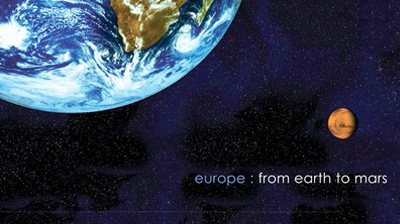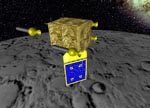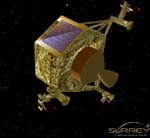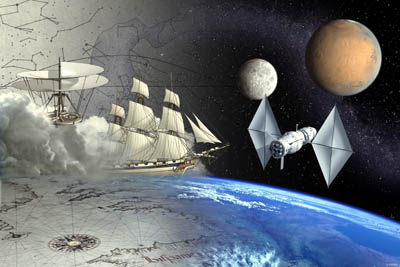ESA - Earth to Mars

_______________________________________________________
Consultations were hosted by the European Space Agency (ESA) and the British National Space Centre (BNSC) in Edinburgh 8/9th January 2007.
Representatives from the UK and other European political, industrial and scientific sectors, together with members of the general public, the various stakeholder groups in Europe with colleagues from across the world, debated the future long-term exploration of the solar system and beyond.
The UK has a vibrant space science and industrial community that already makes a significant contribution to our knowledge economy. Its experience in developing innovative space technology will continue to ensure the UK plays a leading role in both European and global space exploration in the future.
 MoonLITE Credit: SSTL
MoonLITE Credit: SSTLMoonLITE equipped with missile-shaped penetrators carrying seismometers to investigate the lunar interior and a telecommunications capability to demonstrate high data rate telecoms at the Moon.
 Moonraker Credit: SSTL
Moonraker Credit: SSTLMoonRaker, a small propulsive Lander to provide in-situ geological dating.
These mission options exemplify the UK's expertise in small satellites, robotics and miniaturised instruments and MoonLITE's telecoms capability could provide a vital contribution to NASA's ambition of establishing a Moon base by 2020.
The UK is already the second largest European contributor to ESA's Aurora programme of planetary exploration and is currently involved in developing an ambitious Mars Rover project that will fly onboard Europe's ExoMars mission to the Red Planet slated for launch in 2013.

_______________________________________________________
ESA's Aurora Mission
From the dawn of humankind the need to explore has driven expansion across our planet. Today this expansion continues towards other planets in the solar system by means of robotic spacecraft - virtual explorers. But will human expansion continue? In the public consciousness this is only a matter of time. By 2025 an international human mission to Mars may be a reality. It may use the Moon as a way station and to prepare for the great leap. The feasibility of such a mission is being assessed, however, the necessary technology and capability still need to be developed.
Over the next 20 years robotic missions will prepare for human missions, by collecting as much scientific and engineering data as possible, without human scientists in situ. These robotic missions will contribute and demonstrate the technologies needed to put humans on Mars and return them safely to our planet.
Some of the key technologies for a human mission are also very important to the search for life in situ on the red planet and on other solar systems, planets and moons. Soft and precision landing, drilling and sample return, will not just be demonstrated for the sake of technology. These missions will carry sophisticated exobiology payloads and provide answers to some key questions on the origin of life in the solar system and possible causes for its extinction.
A challenging and complex return mission to collect a sample on Mars might also involve our first attempt at interplanetary exploitation. Instead of lugging propellant for the return trip all the way from Earth, the lander systems could include technology that would generate rocket fuel from Martian resources.
Ultimately, though, Mars exploration plans should result in an even greater adventure - a human mission. Astronauts are vastly more capable than even the smartest robot, but they are also vastly more difficult and expensive to transport. Unlike robots, they eat and breath; and if their environment is too uncomfortable, they can become tetchy and depressed. For a human Mars expedition to be possible, new technologies will have to be developed and tested: not only soft-landing methods and in-situ fuel processing, but life-support engineering for a long haul far from home and perhaps entirely new rocket systems, possibly based on new types of propulsion, which will reduce the time spent coasting through space.
By 2025 A human Mars mission, perhaps with the Moon as a first target or even as a way station to the Red Planet, would represent the culmination of the programme's efforts. And just incidentally, it would also guarantee that there was life on Mars: human life.
Read more European workshop on space exploration from ESA
Europe forges long-term strategy for Space Exploration by PPARC
_______________________________________________________
_______________________________________________________


<< Home